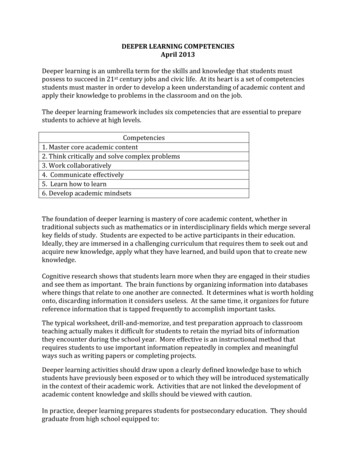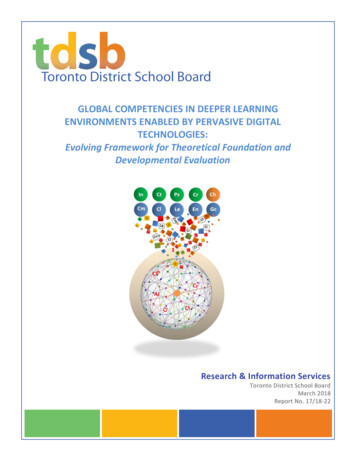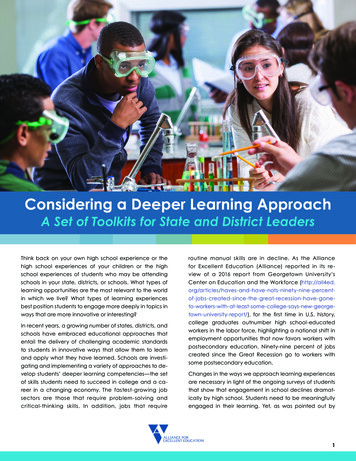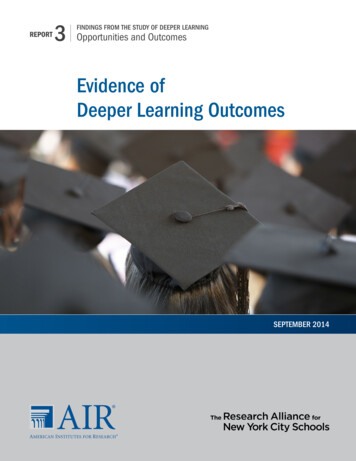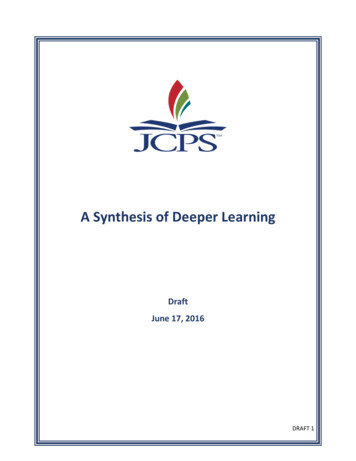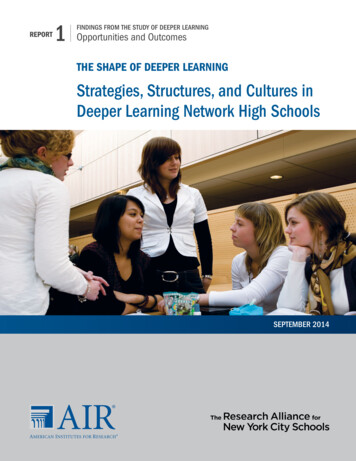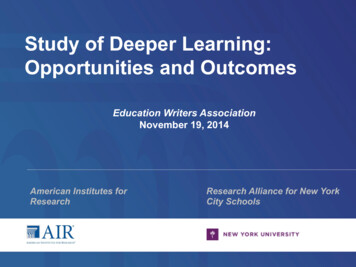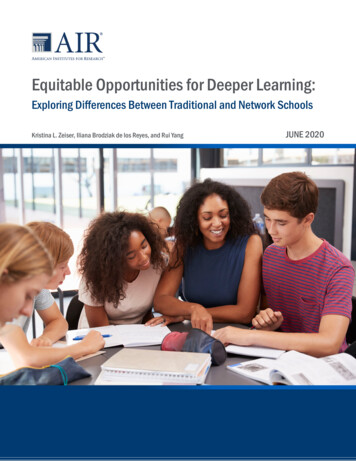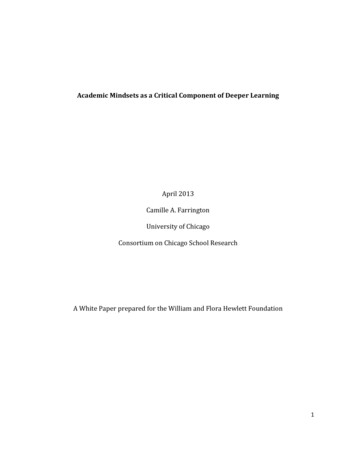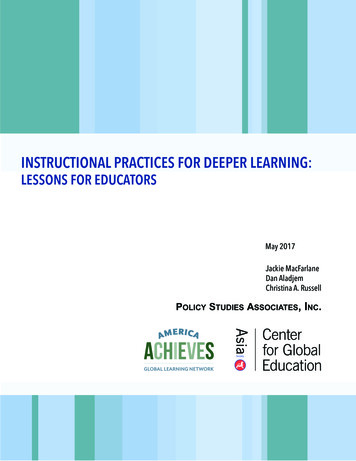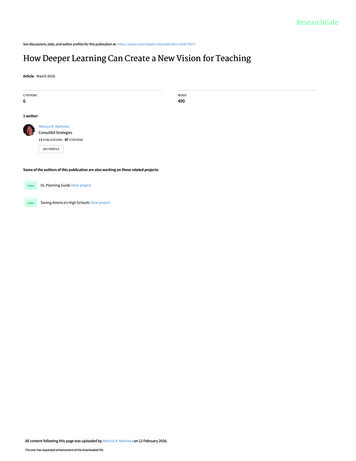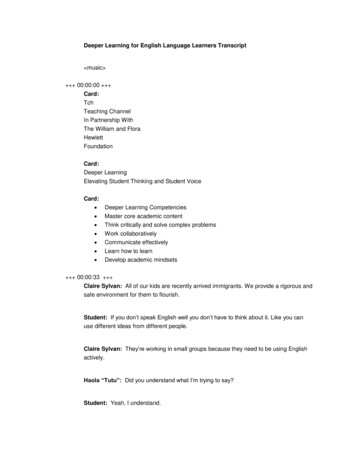
Transcription
Deeper Learning for English Language Learners Transcript music 00:00:00 Card:TchTeaching ChannelIn Partnership WithThe William and FloraHewlettFoundationCard:Deeper LearningElevating Student Thinking and Student VoiceCard: Deeper Learning Competencies Master core academic content Think critically and solve complex problems Work collaboratively Communicate effectively Learn how to learn Develop academic mindsets 00:00:33 Claire Sylvan: All of our kids are recently arrived immigrants. We provide a rigorous andsafe environment for them to flourish.Student: If you don’t speak English well you don’t have to think about it. Like you canuse different ideas from different people.Claire Sylvan: They’re working in small groups because they need to be using Englishactively.Haola “Tutu”: Did you understand what I’m trying to say?Student: Yeah, I understand.
Haola “Tutu”: Okay. 00:00:57 Fred Wambolt: They’re able to spend quality time delving deeply into subjects thatwarrant more than learning some cursory facts.Jordan Wolf: You need a good verb that describes going into a cell taking the DN Student: Extract.Jordan Wolf: Extract. With English language learners you need repetition of topics andconcepts and language and vocabulary.Faiza: We thought it was a time of reform where there’s a lot of people trying to reach outfor their American dreams, but then it seems to be impossible. 00:01:23 Fred Wambolt: Over time, the language barriers start to get smaller and smaller. Thetwelve graders, they’re mixed hanging out speaking English. music 00:01:35 Card:Deeper Learning for English Language LearnersFeatured organization:Internationals NetworksLower Third:Flushing International High SchoolFlushing, New YorkRosmery Milczewski: Hi, good morning, Class F.Students: Good morning, Miss.Lower Third:Claire SylvanInternationals Network for Public SchoolsExecutive Director
00:01:51 Claire Sylvan: All of our kids in the vast majority of our schools are recently arrivedimmigrants. We expect diversity and we honor it and we are thrilled that our studentscome to us from 119 countries, speak 90 languages. Some of them come in without aword of English but are fully fluent and literate in their home languages.Lower Third:9th/10th Grade Integrated AlgebraRosmery Milczewski: But can you translate it for me, please.Lower Third:Summarize what you did today and explain what you did answers the essential question.Student: subtitled Summarize what you did today and explain what you did answersthe essential question. 00:02:22 Claire Sylvan: Approaching learning in a very deep way works for these kids. Weprovide a rigorous and safe environment for them to flourish through project basedlearning.Rosmery Milczewski: Take a look at that space and come up with at least one questionthat can become a mathematics problem.Lower Third:Rosmery Milczewski9th/10th Grade Math TeacherFlushing International High School, Flushing, New York 00:02:47 Rosmery Milczewski: I came to this country when I was 16. Just like my students Icame with no knowledge of English. And I went to the International High School at LaGuardia Community College. Ever since then I felt like everything that my teachers did forme, the best way to pay it off was by going into teaching and doing the same thing theydid for me.Rosmery Milczewski: What mathematical concept is that question asking?Chao: It may ask about volume or area.
Rosmery Milczewski: Or area.Rosmery Milczewski: I can relate to them but more importantly they can relate to them.Rosmery Milczewski: subtitled What is the height of the wall that is in the back? 00:03:21 Student: subtitled What is the height of the wall that is in the back?Rosmery Milczewski: Okay. What is the height of the The wall.Student: subtitled The wall.Rosmery Milczewski: The wall in the back. Yes.Rosmery Milczewski: The one common language we have is English. Whether it’sperfect or not we have to force ourselves to get our message across, to suffer andstruggle with that is how they’re going to be learning.Chao: The angle this one.Student: This one is 24. 00:03:48 Rosmery Milczewski: I wanted them to answer this essential question of this unit whichis about how can we measure length indirectly? This lesson is part of the one projectwe’re working on currently. It is about making a scale model of the school building. So thekids went outside to measure the height of the different trees or different objects thatsurround the school building. music Student: One hundred eighty-four.
Rosmery Milczewski: So they needed to indirectly measure them using the inclinometerwhich will help them measure the angle of elevation. music Lower Third:Chao10th Grade StudentFlushing International High School, Flushing, NY 00:04:21 Chao: Before I came to this school my English is terrible. I afraid to raise my hand and Idon’t think I can’t talk to anyone in English.Chao: Last one.Student: Yeah, the last one.Chao: The front tree.Chao: I feel comfortable at class. I can practice my English in class. I can make friendsin my class. music 00:04:46 Claire Sylvan: They’re working in small groups because they need to be using languageactively. So you make the content accessible and kids may be doing some thinking oreven accessing online materials in their native language, but they’re accessing rigorouscontent but allow them to learn their new language by engaging in very hands on projectsusing English to work together. And they’re using English to present out at that end. 00:05:14 Chao: Through this angle, we can get the length of this side. music Lower Third:9th/10th Grade Biology
Jordan Wolf: All right guys, welcome to another exciting day. We have a lot of stuff toget done this week. The first thing take out your fish journals from last week.Lower Third:Jordan Wolf9th/10th Grade Science TeacherFlushing International High School, Flushing New YorkJordan Wolf: Through this project based environment you see a thread develop fromday to day. Especially with English language learners you need repetition of topics andconcepts and language and vocabulary. 00:05:44 Jordan Wolf: We need a good verb that describes going into a cell taking the DNA.Student: Extract.Jordan Wolf: Extract. So we extracted your DNA last week. This week, we need to copyyour DNA.Jordan Wolf: If what you do in Monday is related to what you’re doing for the next threeweeks you start to see students take ownership of the language and the new vocabulary.Today, we’re looking at a pretty abstract process of DNA replication. 00:06:11 Jordan Wolf: All of the words we need for today template, replicate, et cetera. These arealso on your paper. Try and give us your best translation into your language, what dothese words mean?Jordan Wolf: I want to see if I’m accessing anything that they all ready know. I wantthem to realize that if you know it in your native language as well as in English you’redeveloping literacy in two places, in two languages.Lower Third:Heidi10th Grade StudentFlushing International High School, Flushing, NY
Heidi: I think it helps you learn more English because they put you in groups that have adifferent nationality than you are, so you really have to talk in English. So I think that helpsin your English learning.Jordan Wolf: Go all the way into the pink and explosion sound spit out the DNA. 00:06:54 Jordan Wolf: The project is always hands on. The project is always giving themsomething more than just words to grab on to. The language becomes a vehicle fordescribing what’s going on in the classroom.Jordan Wolf: That’s it. Not-- ugh! Just a little bit and then go in.Jordan Wolf: At the beginning of the year I look at it and say, oh wow, this kid doesn’tspeak any English. You know, and at some point during the year I’m looking at theirwriting, I’m hearing them talk in class and I say, okay you got it. You’re fluently gettingthrough a two-minute conversation. When somebody gets to that point of speaking andinteracting you know that they’ve kind of made it. music Lower Third:Brooklyn International High SchoolBrooklyn, New York 00:07:35 Claire Sylvan: Having students who understand how to navigate a global world andspeak multiple languages is a huge strength. Critical thinkers who can communicate well,who can cite evidence for their views and can work with diverse groups of people cancollaborate really across diversity is not just an idea but is a reality.Lower Third:11th Grade Humanities ClassFred Wambolt: Good morning, Class. Is everyone in the station that they left offyesterday?Students: Yes.Fred Wambolt: Okay. Let’s take about three to five minutes to just finish up. If you havefinished, talk with each other.
Lower Third:Fred Wambolt11th Grade Humanities TeacherBrooklyn International High School, Brooklyn, NY 00:08:13 Fred Wambolt: The fact that the students are English language learners is always in mymind. But I plan my courses in the same way that I would plan if I were teaching all nativelanguage speakers. The goal is the same. There have to be some scaffolds to help themreach that goal.Student: Mien Lu [ph?] was an area where they were many Haola “Tutu”: Viet Cong.Student: Viet Cong Communists in this out fighting against the Americans. 00:08:44 Fred Wambolt: There’s one section where they’re reading to get some information to fillout a timeline. Some of the information that they were accessing from website, it wasfilled with a lot of jargon that they just weren’t able to sift through. So I kept thesophistication of the language but scaffolded to not include so much jargon that theywould just be lost in it.Student: They went deeper in the south.Haola “Tutu”: They went deeper. 00:09:17 Teacher Aid: Which is what they’re trying to do, right. They’re trying to go keeper into thesouth.Haola “Tutu”: Okay.Teacher Aid: Good.
Fred Wambolt: We’re reading “The Things They Carried” which is a novel about theVietnam War. So the activity today was designed for them to access as much backgroundinformation as they could about the Vietnam War to place the novel in the proper context.Haola “Tutu”: Did you understand what they’re trying to say?Student: Yeah, I understand.Haola “Tutu”: Okay.Fred Wambolt: The project based learning definitely leads to deeper learning in so manyways. They’re able to spend quality time delving deeply into subjects that warrant morethan learning some cursory facts.Haola “Tutu”: Can I ask you a question?Student: Yeah.Haola “Tutu”: North is the good or the bad?Student: North is the bad.Haola “Tutu”: Oh yeah, because they wanted to go deeper into the south.Lower Third:Haola “Tutu”11th Grade StudentBrooklyn International High School, Brooklyn, NY 00:10:12 Haola “Tutu”: Study is very different from the school that I have been because it’s likehere they teach for you to understand. I learn from these students just because theirEnglish is kind of low but they’re good at something and they have something too, toshow. So working with them is going to show me how to use their knowledge, too, to helpothers. So it’s not just about me.Fred Wambolt: Who else was surprised?
Haola “Tutu”: People back home.Fred Wambolt: Right.Haola “Tutu”: Because they heard that America was losing.Fred Wambolt: It’s really a family and a community more than other places that I’vebeen. It’s very collaborative in all aspects. 00:10:48 Student: Everyone is here in the school learning English so you don’t have to think that ifyou don’t speak English well you don’t have to think about it. You can use different ideasfrom different people and makes you think and makes you organized. music Fred Wambolt: Over time, the language barriers start to get smaller and smaller. Andthen if I walk down the hall to the 12th graders, they’re mixed, hanging out speakingEnglish. music Lower Third:12th Grade English Class 00:11:21 Shahzia Pirani-Mellstrom: We’re going to continue working on project today for “TheGreat Gatsby.” Who would like to share with the class? Go ahead, Faiza.Faiza: Okay. How does F. Scott Fitzgerald’s character in “The Great Gatsby” serve as areflection of society in America during the 1920s? So we thought it was a time of reformwhere there’s a lot of people trying to reach out for their American dreams but then itseems to be impossible.Lower Third:Shahzia Pirani-Mellstrom12th Grade Humanities TeacherBrooklyn International High School, Brooklyn, NY
Shahzia Pirani-Mellstrom: I teach a course that I call American studies. It’s English butwhat we do is we study the history around a novel, poetry, essays, whatever we’rereading, we’re looking at the history around that piece. 00:11:58 Shahzia Pirani-Mellstrom: I want to move us towards your projects which you startedyesterday. I’d love it if everybody could sort of just tell the class what project you’reworking on.Shahzia Pirani-Mellstrom: The way project based looks or works in my class is thatwe’ll read a piece and as they’re reading, they’re doing collaborative work. They’reinvestigating a question. With “The Great Gatsby” project I tried to give them five or sixchoices.Lower Third:We are planning to write the eulogy.Student: subtitled We are planning to write the eulogy.Lower Third:Trying to create a movie trailer.Student: subtitled Trying to create a movie trailer.Lower Third:We are going to film ourselves.Student: subtitled We are going to film ourselves.Lower Third:We want to do a playlist of songs.Student: subtitled We want to do a playlist of songs. 00:12:33 Shahzia Pirani-Mellstrom: The scaffolds that I sort of tried to put together is reallylooking at symbolism, looking at dialog, looking at plot development, looking atcharacterization, looking at themes.Shahzia Pirani-Mellstrom: Either about the social classes, about race, about men andwomen.
Student: From Jordan’s point of view.Shahzia Pirani-Mellstrom: You don’t have to do it from Jordan’s point of view today.Student: Or just to be from a general.Shahzia Pirani-Mellstrom: Yeah, you can do it in general.Student: I feel if you’re going to write a personal letter you will have to take from thescene in the movie.Faiza: A letter, right. Okay. A love letter.Student: A love letter.Lower Third:Faiza12th Grade StudentBrooklyn International High School, Brooklyn, NY 00:13:07 Faiza: I came here and I had a little more English than some of the students because Iwent to middle school. So I was always trying to help out. And I know some students hadmore English than I did. So it’s like you understand that we need each other. So we helppush each other forward.Lower Third:This one is to talk to Jay Gatsby or talk to someone else.Student: subtitled This one is to talk to Jay Gatsby or talk to someone else.Student: Because Jay Gatsby all ready died.Student: Yes.Student: So we need to talk to other people.Student: About him?
Student: About him.Student: Okay. 00:13:34 Shahzia Pirani-Mellstrom: The International’s work has always been common core.We’ve always looked for evidence. Have students really support what they’re thinking anddoing with evidence. We have always analyzed literary text. To me, that’s really deeperlearning.Student: You cannot own someone’s love.Shahzia Pirani-Mellstrom: Okay. So I see you’re saying a theme is that love cannot bepossessed.Student: Yes. 00:13:57 Claire Sylvan: Our kids have a contribution to make. They’re learning to think verycritically, communicate well. And can collaborate really across diversity.Faiza: Our situation is like magnet. Every time you put them together they go in theopposite direction. music Shahzia Pirani-Mellstrom: I really feel like my seniors are at this point with all of thework that they’ve done it’s just made them adults. It’s made them ready for college whichmakes me really proud.#### End of internationals network deeper learning for english language learners
Deeper Learning for English Language Learners Transcript music 00:00:00 Card: Tch Teaching Channel In Partnership With The William and Flora Hewlett Foundation Card: Deeper Learning Elevating Student Thinking and Student Voice Card: Deeper Learning Competencies Master core academi

